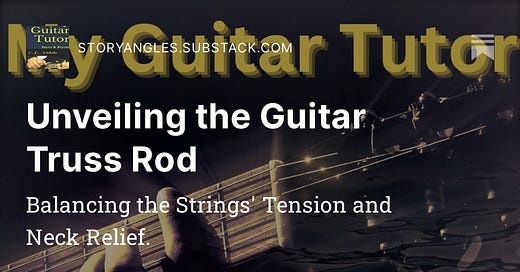Unveiling the Guitar Truss Rod
Balancing the Strings' Tension and Neck Relief
Introduction:
The guitar truss rod is an essential component found within the neck of most steel-string and electric guitars. It plays a vital role in maintaining the instrument's structural integrity and adjusting its playability. By understanding the truss rod's function and its impact on the instrument's performance, guitarists can optimize their playing experience and ensure their instrument stays in excellent condition. This article explores the intricacies of the guitar truss rod, from its purpose and construction to the adjustment process.
Purpose of the Truss Rod: The primary purpose of the guitar truss rod is to counteract the tension exerted by the strings on the neck. As strings are tightened, they exert a significant force, which can cause the neck to bend forward (called "neck bow"). The truss rod serves as a counterbalancing mechanism, allowing the adjustment of neck relief to maintain optimal playability.
Construction and Location: The truss rod is typically a metal rod, usually made of steel, inserted into a channel running along the length of the guitar neck. It is most commonly positioned beneath the fingerboard, but in some guitars, it may be accessible from the headstock end or located at the heel of the neck.
Types of Truss Rods: There are primarily two types of truss rods: single-action and dual-action.
a. Single-Action Truss Rod: Single-action truss rods can only adjust the neck in one direction, typically countering forward bow caused by string tension. They are often adjusted using an Allen wrench or a specialized tool inserted into the truss rod access point.
b. Dual-Action Truss Rod: Dual-action truss rods offer more versatility by allowing adjustments in both directions. Besides addressing forward bow, they can also correct backward bow or excessive relief. Dual-action truss rods are adjusted similarly to single-action rods but require a bit more care and caution.
Truss Rod Adjustment: To adjust the truss rod, guitarists need to strike a balance between string tension and neck relief, achieving optimal playability. Truss rod adjustment should be done incrementally, usually with small turns of the wrench, and accompanied by proper measurements of neck relief to avoid damage. It is essential to follow the manufacturer's guidelines or consult a professional guitar technician if unsure about the process.
Effects of Truss Rod Adjustment: Correct truss rod adjustment ensures the guitar's playability and prevents common issues associated with incorrect neck relief. Overly concave necks (back bow) may cause string buzzing and high action, while excessive forward bow can lead to high action and fretting out. The goal is to achieve a slight relief that allows comfortable string action without buzzing.
Factors Affecting Truss Rod Adjustment: Several factors can influence the truss rod adjustment process. These include string gauge, playing style, climate, and changes in humidity and temperature. Environmental fluctuations can cause the neck to expand or contract, affecting its relief and requiring occasional adjustments.
Conclusion:
The guitar truss rod is a crucial component that allows guitarists to maintain proper neck relief, ensuring optimal playability and avoiding common performance issues. Understanding its purpose, construction, and adjustment process empowers musicians to fine-tune their instruments and achieve a comfortable playing experience. Whether it's a single-action or dual-action truss rod, proper care and cautious adjustment can significantly enhance a guitarist's relationship with their instrument.
The following articles should provide even more understanding to what you need to know about the guitar truss rod, its uses, and how to adjust it to create the great sound that your guitar can produce.
Keep reading with a 7-day free trial
Subscribe to My Guitar Tutor Online to keep reading this post and get 7 days of free access to the full post archives.




